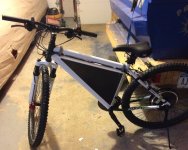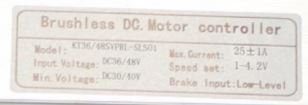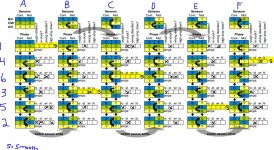TJImagineer
1 mW
Hi I have been reading the forums on this site for about 2 months while attempting to build my first bike. please excuse me if I have missed one of the posts that already addresses my problem but I have yet to find answers to my problems.
I built my battery pack over the past 6 weeks from recovered LG 18650 cells from Dell Laptops. Design is 13s10p (quite a long process to test each battery and package equal voltage and capacity cell/banks.) in the end I have the battery completely built and it has 25.6ah per parallel bank (all parallel banks were built to have capacity within 0019Mah of each other). no batteries with less than 2300Mah were used and my max capacity on a few batteries was 2800Mah. I used braided copper for all parallel and series connections, and connected a 48v 13s BMS from China
Specs:
Operating Temperature: -20℃-70℃
Dissipation Power: less than 20uA
Brand Name:ANN
Supply Voltage:48V
Model Number: 13S48V40A
Type:13S 48V Batteries Protection Board
Application:13S 48V 1000W-2500W li-ion battery
Application:3.7V lithium ion battery
Continuous Working Current:40A
Max discharge protection current:100A
With balance function:Yes
Size:L110*W85*H15mm (4.33” X 3.34” X .6”)
Product Description 48V 40A BMS, 13S 48V(54.6V) li-ion battery protection board, 40A continuous 100A peak discharge
I used 10Ga silicone wire for my leads to the controller and charger and XT60 bullet connectors. When fully charged the battery reads 54.5v, I don't believe there is any problem with my battery, BUT the hub motor kit I purchased from Hallomotor (48v 1500w 29" Rear Wheel Ebike Conversion Kit with Sine Wave Controller+LCD) is not working correctly.
PROBLEM: When connected to the bike and I press the thumb throttle I get a short less than a second blip from the motor then it cuts out. press the thumb throttle again and the same thing less than 1 second and the motor quits. if I lift the rear tire off the ground and hit the thumb throttle it spins up as desired and hits 46MPH drawing 10.6amps max and a 2.7v sag down to 51.8v. as soon as I place the wheel on the ground and hit the throttle I get the short pulse and the motor quits. when I tried to ride the bike and use the PAS I get the exact same result a brief pulse of power from the motor and it quits. So the Thumb throttle and the PAS are acting the same. I have tested the Phase wires to the motor and get cogging when I short any 2 wires together. I have tested the hall wires for variable voltage when manually spinning the wheel all three show variable voltages. The throttle is showing good voltage, ground and varies voltage when turned. I have been contacting the manufacturer for support for 2 weeks and they are in china so each email takes 2 days to get help which has been minimal so far. They say I have a battery or controller problem. All of the testing I have done is a result of reading these forums and I feel I have exhausted all of the tests I can think of to get this up and running. Do any of you with years of Ebike experience have any ideas what my problem is. I am ready to get ebay involved and ship the whole kit back to China and request a refund. ANY help or advice is greatly appreciated, Frustrated in Rochester NY!
I built my battery pack over the past 6 weeks from recovered LG 18650 cells from Dell Laptops. Design is 13s10p (quite a long process to test each battery and package equal voltage and capacity cell/banks.) in the end I have the battery completely built and it has 25.6ah per parallel bank (all parallel banks were built to have capacity within 0019Mah of each other). no batteries with less than 2300Mah were used and my max capacity on a few batteries was 2800Mah. I used braided copper for all parallel and series connections, and connected a 48v 13s BMS from China
Specs:
Operating Temperature: -20℃-70℃
Dissipation Power: less than 20uA
Brand Name:ANN
Supply Voltage:48V
Model Number: 13S48V40A
Type:13S 48V Batteries Protection Board
Application:13S 48V 1000W-2500W li-ion battery
Application:3.7V lithium ion battery
Continuous Working Current:40A
Max discharge protection current:100A
With balance function:Yes
Size:L110*W85*H15mm (4.33” X 3.34” X .6”)
Product Description 48V 40A BMS, 13S 48V(54.6V) li-ion battery protection board, 40A continuous 100A peak discharge
I used 10Ga silicone wire for my leads to the controller and charger and XT60 bullet connectors. When fully charged the battery reads 54.5v, I don't believe there is any problem with my battery, BUT the hub motor kit I purchased from Hallomotor (48v 1500w 29" Rear Wheel Ebike Conversion Kit with Sine Wave Controller+LCD) is not working correctly.
PROBLEM: When connected to the bike and I press the thumb throttle I get a short less than a second blip from the motor then it cuts out. press the thumb throttle again and the same thing less than 1 second and the motor quits. if I lift the rear tire off the ground and hit the thumb throttle it spins up as desired and hits 46MPH drawing 10.6amps max and a 2.7v sag down to 51.8v. as soon as I place the wheel on the ground and hit the throttle I get the short pulse and the motor quits. when I tried to ride the bike and use the PAS I get the exact same result a brief pulse of power from the motor and it quits. So the Thumb throttle and the PAS are acting the same. I have tested the Phase wires to the motor and get cogging when I short any 2 wires together. I have tested the hall wires for variable voltage when manually spinning the wheel all three show variable voltages. The throttle is showing good voltage, ground and varies voltage when turned. I have been contacting the manufacturer for support for 2 weeks and they are in china so each email takes 2 days to get help which has been minimal so far. They say I have a battery or controller problem. All of the testing I have done is a result of reading these forums and I feel I have exhausted all of the tests I can think of to get this up and running. Do any of you with years of Ebike experience have any ideas what my problem is. I am ready to get ebay involved and ship the whole kit back to China and request a refund. ANY help or advice is greatly appreciated, Frustrated in Rochester NY!




